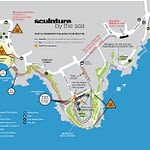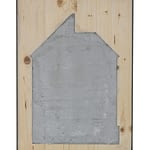Andreas Fischbacher and Tobias Gossow
The connecting element of the two artists is the respective starting point of a photographic model for their painting. While Fischbacher mainly uses old black-and-white photographs from the period around the Second World War, Gossow uses her own photographs as well as images from various magazines.
Curated by Lucas Cuturi
Tobias Gossow always uses only two colours in what he calls his “duochrome” acrylic painting. One color for priming the canvas and one color for the clean and clearly drawn lines, which he applies with the help of Chinese chopsticks. The result is a kind of relief that lends depth to the picture.
The themes that he implements in his works deal with the immediate metropolitan living space. He deals with architecture as well as with his young inhabitants. He shows these mainly in leisure activities such as BMX or skateboarding. In his capacity as a cartoonist, the artist is fascinated to create complex facial expressions or spaces with just a few lines. Gossow drives a great need for clarity and clarity. He appreciates the aesthetics of cleanly and clearly drawn lines of a commercial graphic, such as the construction manual of an Ikea shelf or a map. Gossow, however, believes that satisfying this need is doomed to failure, since in his view there will never be a state of total clarity.
Andreas Fischbacher works with oil, mainly in black and white. For targeted effects he sometimes uses one of the three basic colours, red, yellow or blue, to achieve or reinforce a desired mood.
Some of his depictions appear slightly blurred. An optical effect that Fischbacher consciously uses, however, to encourage the viewer to take a closer look. He has, for example, obscured the uniforms of two Nazi officers who are currently at a situation meeting to the effect that the situation to be seen could also be a meeting between two civil engineers. Furthermore, it does not emerge from the situation depicted where exactly this room is located. It could be a room in a magnificent building as well as the command room of a bunker, which is supposed to simulate the existence of a window through the curtain in the background. Fischbacher does not want to conceal the truth with his pictures, but rather emphasizes the fact how manipulative photography can be.
Text: Lucas Cuturi
Exhibition period: October 2010
Exhibition venue: Baeckerstrasse4, 1010 Vienna, Austria
Links: www.andreasfischbacher.net, www.baeckerstrasse4.at/de/menu31/kuenstler29/









